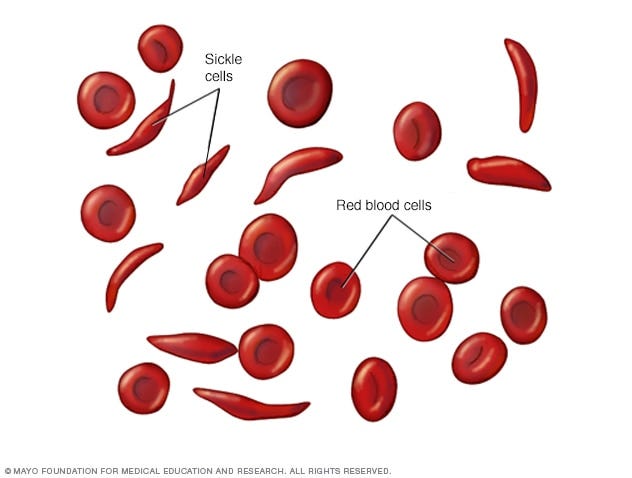What is Sickle Cell Disease?
Sickle Cell Disease (SCD) is a genetically inherited disorder that affects the red blood cells through the abnormality of the protein hemoglobin. The body’s red blood cells play a vital role in maintaining the body’s respiratory activity as their main function is the passage of oxygen to the body’s organs while releasing carbon dioxide to the lungs for exhalation.
The average person’s red blood cells are round and flexible, allowing for an easy flow of these cells throughout the bloodstream. Those affected by SCD possess a quantity of irregular red blood cells. This group of red blood cells shares the characteristics of being sickle, or crescent, shaped, becoming rigid and sticky, and fulfilling a shorter lifespan. Because of their shape and texture, these blood cells can stick together, stopping or slowing blood flow. The absence of a proper bloodstream is extremely dangerous for the body as this disrupts the flow of oxygen to vital organs. Additionally, sickle cells maintain a shorter lifespan meaning that these red blood cells die in 10-20 days while healthy cells live up to 120 days. The shortage of red blood cells is characterized as a disease known as anemia which can be life-threatening based on the circumstances.
SCD is a broader “umbrella” of diseases in which the protein hemoglobin is affected. Sickle cell anemia (SCA) is classified by scientists as the diseases that result in more severe cases of anemia.
Genetics and Data
The irregular sickle shape of one’s red blood cells is caused by a mutation in the HBB gene. This gene plays a role in controlling the body’s production of hemoglobin, a protein that allows red blood cells to transport oxygen throughout the body. For a child’s genes to undergo the HBB mutation, both parents must carry a sickle cell trait and pass it on to their child. Genetic mutations which follow this pattern are known as autosomal recessive diseases.
Data has proved that those most prone to possessing sickle cell anemia are people of African descent. In the US, more than 90% of recorded cases of SCA are from people of an African American or non-Hispanic black race.
Symptoms Associated with SCD/SCA
The most obvious effect of sickle cell disease on one’s body is the development of anemia. The most prominent symptom of anemia is fatigue, the body becoming too tired to perform its routine activities. The feelings of fatigue and dizziness stem from iron deficiency which is a reoccurring factor amongst those with SCA.
Those suffering from SCD/SCA also experience numerous episodes of pain, the frequency of the episodes can range from 2-3 times a year to numerous times a month, and unfortunately become chronic in some cases. Other health issues also start to arise due to the compromised oxygen
flow throughout the body. The most common issues are strokes, caused by the blockage of blood flow to the brain, acute chest syndrome, and vision problems caused by the clotting of blood surrounding the retina.
References
Data and statistics on sickle cell disease. (2024, May 15). Sickle Cell Disease (SCD). https://www.cdc.gov/sickle-cell/data/index.html
Sickle cell anemia - Symptoms & causes - Mayo Clinic. (2022, December 22). Mayo Clinic. https://www.mayoclinic.org/diseases-conditions/sickle-cell-anemia/symptoms causes/syc-20355876
Sickle cell disease. (2024, September 11). Cleveland Clinic.
https://my.clevelandclinic.org/health/diseases/12100-sickle-cell-disease
Written by Laasya Alampali from MEDILOQUY




